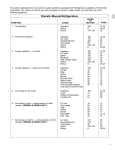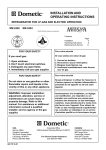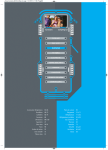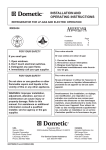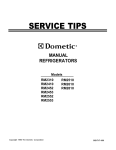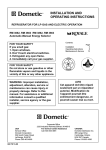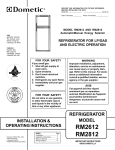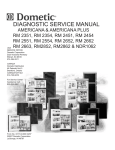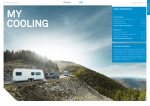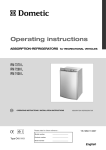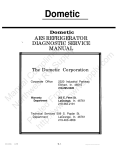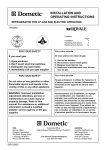Download Dometic RM2453 and Operating instructions
Transcript
REFRIGERATORS AND FREEZERS Model: Dometic RM4401 Part Number: RM4401 • The internal fixing system is standard and ensures easy installation. • Electronic re-ignition for gas operation Gross Capacity: 100 litres approx. Freezer: 12 litres approx. Weight: 29.5 kg approx. Overall Height: Width: Depth: Dimensions: 805.5 mm 525 mm 536 mm Electrical Input: Electric: 240V - 135 Watts 12V - 130 Watts Gas Input: LP Gas: 18 g/hr Model: Dometic RM2453 Part Number: RM2453 • Wide metal mounting flanges for built-in application - no exterior skin • Door reversing kit available, part number 2932750-02 Gross Capacity: 120 litres approx. Freezer: 15 litres approx. Weight: 41 kg approx. Overall Height: Width: Depth: Dimensions: 948 mm 632 mm 627 mm Recess Height: Width: Depth: Index Required: 928 mm 602 mm 610 mm Electrical Input: Electric: 240V - 195 Watts 12V - 175 Watts Gas Input: LP Gas: 18 g/hr INSTALLATION AND OPERATING INSTRUCTIONS REFRIGERATOR FOR LP-GAS AND ELECTRIC OPERATION RA/RM-1D RM 2453 RM 2553 Contents: Installation Operating Instructions Maintenance & Service FOR YOUR SAFETY If you smell gas: 1. Open windows. 2. Don’t touch electrical switches. 3. Extinguish any open flame. 4. Immediately call your gas supplier. FOR YOUR SAFETY Do not store or use gasoline or other flammable vapors and liquids in the vicinity of this or any other appliance. WARNING: Improper installation, adjustment, alteration, service or maintenance can cause injury or property damage. Refer to this manual. For assistance or additional information consult a qualified installer, service agency or the gas supplier. 822 70 36-01 Page 3 7 9 Heaters Cover, Terminal block Flue baffle 12 Volts DC 12 Volts DC Heater Reigniter Protection cover Evaporation Tray Screw for protection cover 12 volt terminal block Inlet fitting FIG. 1 Burner jet Manual gas shutoff valve Flexible cord Drain water hose Refrigerator control panel A E D C B OFF AC OFF ON FUEL SELECTOR FLAME PUSH WHEN LIGHTING THERMOSTAT LEGEND A. ON/OFF, Fuel Selector Switch B. Thermostat Knob, Gas/Electric C. Flame Failure Safety Valve Push-button D. Piezo Igniter E. Flame Indicator FIG. 2 2 DATA PLATE INSTALLATION Check the data plate, inside the refrigerator, to ensure that you have received the right model. GENERAL INSTRUCTION This appliance is designed for storage off foods and storage of frozen foods and making ice. This appliance must be installed by an authorised person and conform to all relevant local authorities. The appliance shall be installed in accordance with the manufacturer’s installation instructions, local gas fitting regulations, municipal building codes, electrical wiring regulations, the AS 5601 Gas Installations, and any other relevant statutory regulations. The right gas pressure is ........... 2,7 kPa. The right voltage is ........... 230 - 240 volt. The data plate contains e.g. the following details: Model designation .................................... Product number .................................... Serial number .................................... Since these details will be needed if you have to contact service personnel, it is a good idea to make a note of them here. The refrigerator must be installed on a solid floor and must be level. With the vehicle carefully levelled, the refrigerator should level both ways in the freezer compartment. (More about levelling is to be found under the heading “Operating instructions”). Free air circulation over the fins of the cooling unit is essential. In case detailed instructions on the installation and connection to the gas supply are required, contact your dealer or distributor. FIG. 3 Side view NOTE: Wood Strip MUST be in place View from above C D D H A Overall Dimensions Refrigerator Model W B Recess Dimensions Height A Width B Depth C Height H Width W Depth D RM 2453 mm 948 632 627 928 602 610 RM 2553 mm 1104 632 627 1083 602 610 This methods of installation and these clearances will give you adequate space for service and proper installation. 3 INSTALLING REFRIGERATOR IN ENCLOSURE NOTE: DO NOT install the appliance directly on carpeting. Carpeting must be removed or protected by a metal or wood panel beneath the appliance, which extends at least full width and depth of the appliance. NOTE: A wood strip must be in place across the upper opening of the enclosure. The top frame of the refrigerator will be anchored to the wood strip with screws. See FIG. 3 page 3. The refrigerator must be installed in a substantial enclosure and must be level. When installing the refrigerator in the enclosure, all areas within the recess in which the refrigerator is installed must be sealed. Make sure that there is a complete seal between the front frame of the refrigerator and the top, sides and bottom of the enclosure. A length of sealing strip is applied to the rear surface of the front frame for this purpose, see FIG. 4. The sealing should provide a complete isolation of the appliance’s combustion system from the vehicle interior. NOTE: Be careful not to damage the sealing strip when the refrigerator is put in place. 1 2 FIG. 5 2. Once the lower front strip is slipped under the hinge, the part is possible to swing into place as shown in FIG. 6. 3 FIG. 6 FIG. 4 Securing the Refrigerator After the refrigerator is put in place, (ensuring a combustion seal at the front frame), the refrigerator is to be secured in the enclosure with six screws (not included). The screws have to be installed in the following order: STEP 1: Two screws installed through the front base, which includes the lower front strip installation. The refrigerator is provided with a lower front strip (shipped as a loose part). The front strip is to be attached after the refrigerator is set into the cut-out opening. 1. Install the lower front strip by sliding it under the bottom hinge plate, as shown in FIG. 5. The hinge plate can be on the right or left side depending on the door swing. 4 3. Secure the refrigerator and the lower front strip with two screws: One screw through the hinge, and on the opposite side one screw through the lower front strip. (FIG. 6). STEP 2: Two screws installed in the top frame. The top decoration panel must be removed from the refrigerator before the screws can be installed. Open the door and gently push the tabs out of the hole in the hinge with a flat blade screwdriver, (both sides). See FIG. 7. Carefully tilt the top decoration panel and lift up to remove from top frame. Install the two screws in the top frame, the holes are accessible from underneath. Seal the opening for the screws with aluminium tape. ! WARNING DO NOT use a flame to check for gas leaks. 2 FIG. 7 1 Replace the top decoration panel. Make sure the tabs snap back into the holes in the hinge plate. STEP 3: Two screws installed in the rear base. See FIG. 8. The gas supply system must incorporate an approved gas pressure regulator to maintain a supply pressure of 2,75 kPa . When testing the gas supply system at test pressures in excess of 1/2 psi, the refrigerator and its individual shutoff valve must be disconnected from the gas supply piping system. When testing the gas supply system at pressures less than or equal to 1/2 psi, the appliance must be isolated from the gas supply piping system by closing its individual manual shutoff valve. In case detailed instructions on the installation and connection to the gas supply are required, contact your dealer or distributor. TESTING LP GAS SAFETY SHUTOFF The gas safety shutoff must be tested after the refrigerator is connected to the LP gas supply. FIG. 8 Failure to follow the sequence in securing the refrigerator in the enclosure can cause leakage between the frame and cabinet. Any space between the counter, storage area or ceiling and top of the refrigerator greater than 40 mm should be blocked. The heat produced at the rear of the refrigerator will become trapped in this space, making the top of the refrigerator hot and reduce the efficiency of the refrigerator. LP GAS CONNECTION The refrigerator is designed for operation on LP-gas, the pressure of which must be 2,7 kPa for Propane. Check that this is stated on the data plate. To test the gas safety shutoff, proceed as follows: 1. Start the refrigerator according to the instructions for LP Gas Operation. See section Operating Instructions. 2. Check that the gas flame is lit. This can be observed on the flame indicator E. The red indicator is in the green field, (ON). 3. Close the gas valve by turning the knob A back to “OFF” position. 4. Wait for one minute. 5. Remove protection cover (see FIG. 1). Open the gas valve by turning knob A to position “GAS” without pushing the buttons C and D. Apply a non-corrosive commercial bubble solution to the burner jet. Be careful not to damage the burner jet. 6. No bubbles should appear at the opening of the burner jet. The presence of bubbles indicates a defective gas safety shutoff, and service is required. 7. If no bubbles were present at the burner jet, the gas safety valve is working properly. Rinse jet thoroughly with fresh water before proceeding. Be careful not to damage the burner jet. Replace the protection cover and turn the main switch OFF and back ON. See instruction for LP Gas Operation , section Operating Instructions. Normal operation of the burner should return. Allow the burner to operate for a minimum of 5 minutes. The refrigerator is not designed for operation on town gas or natural gas. Hook up to the gas supply line is accomplished at the manual gas valve, which is furnished with a ISO 7/1 -Rp 1/8 internal pipe thread connection. All completed connections should be checked for leaks with soapy water. 5 ELECTRICAL CONNECTION 230-240 Volts AC Connection The electrical installation must be carried out in a proper and durable manner, taking into account all relevant regulations and codes of practice. Check that the voltage stated on the data plate is the same as the mains voltage in use (230-240V). DO NOT use the chassis or vehicle frame as one of the conductors. Connect two wires at the refrigerator and route to the 12 V DC supply. The refrigerator will draw 15 amps at 12 volt DC. MAXIMUM TOTAL CONDUCTOR WIRE LENGTH (in metre) Wire length For mains voltage operation, it is important that the circuit to and in the caravan is effectively earthed. The refrigerator is equipped with a three-prong (grounding) plug for your protection against shock hazards and should be plugged directly into a properly grounded threeprong receptacle. DO NOT cut or remove the grounding prong from this plug. The free length of the cord is 1.8 m and therefore recommended that the receptacle be located to the left side of the refrigerator (viewed from the rear) and approximately 150 mm from the floor. (See FIG. 9). This allows easy access through the vent door. The cord should be routed to avoid direct contact with the burner cover, flue cover or any other components that could damage the cord insulation. 230-240 Volt AC receptacle min.wire size 5m 4 mm2 8m 6 mm2 The connections must be clean, tight and free from corrosion. If not, a resulting voltage drop will cause a decreased cooling capacity. ! CAUTION DO NOT operate the refrigerator on 12 volt when the vehicle is parked. The amperage draw of the 12-volt DC heating element can discharge a battery in a very short time. The installation of a 12volt DC operated refrigerator requires a relay to be installed on the tow vehicle or in the caravan. The relay will automatically shut off the 12 volt DC power to the refrigerator when the ignition is turned off. (See FIG. below). 150 mm FIG. 9 Switch key Breaker Ignition point coil Relay Refrigerator 12 Volts DC Connection The connection is made to the terminal block marked “12 volts DC heater”, located at the bottom left corner on the back of the refrigerator cabinet. (See FIG. 1). The refrigerator must be connected to the battery circuit with two wires of adequate capacity to avoid voltage drop. The wire gauge should be chosen with consideration to the wire length in accordance with the table below. To ensure safe operation, the positive lead must be fitted with a fuse rated at 20 amps. Correct polarity must be observed when connecting to the 12 V DC supply. 6 Battery OPERATING INSTRUCTIONS A E D C B OFF AC OFF ON FUEL SELECTOR FLAME PUSH WHEN LIGHTING IMPORTANCE OF LEVELING A REFRIGERATOR In an absorption refrigerator system, ammonia is liquefied in the finned condenser coil at the top rear of the refrigerator. The liquid ammonia then flows into the evaporator (inside the freezer section) and is exposed to a circulating flow of hydrogen gas, which causes the ammonia to evaporate, creating a cold condition in the freezer. When starting this refrigerator for the very first time, the cooling cycle may require up to four hours of running time before the cooling unit is fully operational. The tubing in the evaporator section is specifically sloped to provide a continuous movement of liquid ammonia, flowing downward by gravity through this section. If the refrigerator is operated when it is not level and the vehicle is not moving, liquid ammonia will accumulate in sections of the evaporator tubing. This will slow the circulation of hydrogen and ammonia gas, or in severe cases, completely block it, resulting in a loss of cooling. Any time the vehicle is parked for several hours with the refrigerator operating, the vehicle should be leveled to prevent this loss of cooling. The vehicle needs to be leveled only so it is comfortable to live in (no noticeable sloping of floor or walls). When the vehicle is moving, the leveling is not critical, as the rolling and pitching movement of the vehicle will pass to either side of level, keeping the liquid ammonia from accumulating in the evaporator tubing. LP GAS OPERATION Before starting the refrigerator, check that all the manual gas valves are in the ON position. DO NOT forget the manual shutoff valve on the rear of the refrigerator see FIG. 1. 1. To start the refrigerator, turn knob A to the “GAS” position. 2. Turn the thermostat knob B to position 4. 3. Push the button C in until it reaches the bottom - and hold, push the button D for the piezo igniter several times to light the burner. This can be observed on the flame indicator E. When the flame is on, the red indicator is in the green field, (ON). 4. After the gas is lit keep the button C pressed for 10 seconds. Release the button and check that the RED indicator is in the GREEN field, (ON). 5. To shut off the refrigerator turn the knob A to “OFF” position. THERMOSTAT NOTE: After changing an LP tank, or after a long shutoff period, the gas line is likely to be filled with air. You may have to repeat the lighting procedure several times to purge the air out of the gas lines. ! WARNING DO NOT OPERATE THE REFRIGERATOR ON LP GAS WHILST TRAVELLING 230-240 V OPERATION Before operating the refrigerator, check that the voltage stated on the data plate is the same as main voltage in use. 1. Check to be sure that the power cord is properly connected to the power supply. (See FIG. 9). 2. Turn the knob A to position marked “AC” for 230-240 volt AC operation. 3. Turn the thermostat knob B to position 4. 4. To shut off the refrigerator turn the knob A to “OFF” position. 12 V OPERATION Only operate your refrigerator on 12V when the engine of the vehicle is running - otherwise your battery will soon be discharged. 1. Turn the knob A to the position marked “DC” for 12 volts operation. 2. Note: there is no thermostat function on 12 V DC operation, the refrigerator works continuously. 3. To shut off the refrigerator turn the knob A to “OFF” position. REGULATING THE TEMPERATURE The refrigerator is equipped with a thermostat that can be adjusted by turning the knob B to different setting to maintain the desired cabinet temperature. At OFF In gas operation, the thermostat closes its main valve and the burner runs continuously at the bypass rate, just enough to keep the burner lit. In electrical operation, the contacts in the thermostat are open and the heating elements are off. At MAX In gas operation, the thermostat allows the burner to remain on high flame continuously. In electric operation, the heating element is “ON” continuously. Lowest cabinet and freezer temperatures are obtained at this setting. 7 The thermostat can be adjusted between “MAX” and “OFF” to obtain the desired cabinet temperature. The closer the knob is to “MAX” - the colder the cabinet temperature. The closer the knob is to “OFF” - the warmer the cabinet temperature. When the thermostat reaches the set temperature, it will cut the burner back to bypass or, in electric operation, (230-240 V AC) shut off the heating element. The setting of the thermostat is not critical, but we recommend it be adjust to maintain a dry frost on the cooling fins. Adjust the thermostat knob closer to “MAX” when the outside temperature becomes warm. HOW TO USE THE REFRIGERATOR FOOD STORAGE COMPARTMENT The food storage compartment is completely closed and unventilated, which is necessary to maintain the required low temperature for food storage. Consequently, foods having a strong odor or those that absorb odors easily should be covered. Vegetables, salads etc. should be covered to retain their crispness. The coldest positions in the refrigerator are under the cooling fins and at the bottom of the refrigerator. The warmer areas are on the upper door shelves. This should be considered when placing different types of food in the refrigerator. FROZEN FOOD STORAGE COMPARTMENT Quick frozen soft fruits and ice cream should be placed in the coldest part of the compartment, which is at the bottom of the aluminum liner. Frozen vegetables, may be stored in any part of the compartment. This compartment is not designed for deep or quick freezing of food. Meat or fish, whether raw or prepared, can be stored in the frozen food storage compartment provided they are precooled first in the refrigerator. They can be stored about three times longer in the frozen food compartment as compared to the fresh food compartment. To prevent food from drying out, keep it in covered dishes, containers, plastic bags or wrapped in aluminium foil. Ice cubes can be made in the freezer compartment. For faster ice making, the trays should be placed in direct contact with the bottom of the freezer compartment. Ice making is accelerated if the thermostat knob B is turned to the “MAX” setting. It is a good idea to do this a few hours before the anticipated need for ice, but be sure to turn the thermostat back to the normal setting when the ice is formed. Food in the lower compartment may be frozen if the thermostat is left on “MAX”. DEFROSTING Shut off the refrigerator by turning the knob A to “OFF” position. Empty the refrigerator, leaving the drip tray under the finned evaporator, and the cabinet and freezer doors open. Defrosting time can be reduced by filling the ice trays with hot water and placing them in the freezer compartment. 8 NOTE: Defrost water runs from the drip tray to a receptacle at the rear of the refrigerator where it normally evaporates. (See FIG. 1). With a lot of defrost water as a result of heavy frosts build up on the cooling fins, move the plastic drain tube into a water tight bucket or container, (access through louvered service panel on the outside of the vehicle). When all frost has melted, wipe up the excess moisture and empty the accumulated water from the bucket. Replace the drain tube to its original position. Dry the interior of the refrigerator with a clean cloth. Replace all food and set the thermostat to “MAX” for a few hours, then reset the thermostat to its normal position. ! CAUTION DO NOT use a hot air blower. Permanent damage could result from warping the metal or plastic parts. DO NOT use a knife or an ice pick, or other sharp tools to remove frost from the freezer compartment. They can create a leak in the ammonia system. CLEANING THE REFRIGERATOR Cleaning the refrigerator is usually done after it is defrosted or put into storage. To clean the interior liner of the refrigerator, use lukewarm weak soda solution. Use only warm water to clean the finned evaporator, gasket, ice tray and shelves. NEVER use strong chemicals or abrasives to clean these parts, as the protective surfaces will be damaged. It is important to always keep the refrigerator clean. SHUT- OFF (STORAGE PROCEDURE) To shut off the refrigerator, turn the knob A to “OFF” position. If the refrigerator will not be in operation for a period of weeks, it should be emptied, defrosted, cleaned and the doors left ajar. The ice trays should also be dried and kept outside the cabinet. ! WARNING DO NOT store explosive substances in the refrigerator, such as cigarette lighter gas, gasoline, ether or the like. NOTE: Sodium chromate is used for corrosion protection (less than 2 weight % of the coolant). MAINTENANCE & SERVICE When replacing the refrigerator make sure that the sealing strips are properly positioned. Replacement is the reverse of removal. Check all connections for gas leaks. Refer to section INSTALLATION, page 2 to 6. The user should be aware of service that must be done on a regular schedule to keep the refrigerator operating properly. The service should only be performed by a qualified technician who is familiar with LP gas systems and refrigerators. 3. PERIODIC MAINTENANCE 1. CARTRIDGE HEATER To keep your Dometic refrigerator operating efficiently and safely, periodic inspection and cleaning of several components once or twice a year is recommended. The heat necessary for the operation of an absorption cooling unit is supplied by an electric heater mounted in a pocket of the boiler system. Model RM 2453 and RM 2553 are equipped with two electrical heaters, one for 230-240 volt AC and one for 12 volt DC. To replace the heater proceed as follows: 1. Before working on the refrigerator make sure that 230-240 volt AC and optional 12 volt DC leads are disconnected. Shut off Gas valve. 2. Remove the terminal block cover, see FIG. 1. 3. Disconnect the heater leads. 4. With a pair of pliers unfold the lug holding the lid of the boiler casing and open the lid. 5. Remove some insulation wool so that the heater is accessible. 6. Turn and lift the heater out of its pocket. 7. Fit the new heater into the pocket. 8. Connect the leads and put on the terminal block cover. 9. Reset the insulation and close the lid of the boiler. 2. REFRIGERATOR REMOVAL Before working on the refrigerator, make sure the AC voltage and DC voltage leads are disconnected. Shut off the gas supply at the LP tank. Disconnect the gas supply line at the rear of the refrigerator, see FIG. 1. Always use a back up wrench when loosening and tightening connections. Cap the gas supply line, loosen the screws anchoring the refrigerator to the enclosure and slide the refrigerator out of the compartment. A. It is important to keep the area at the back of the refrigerator clean. Check the lower vent, upper vent and area between these openings for any obstructions such as bird/insect nests, spider webs, etc. Clean the coils on the back of the refrigerator. Use a soft bristled brush to dust off the coils. It is important to keep the refrigerator area free from combustible material, gasoline and other flammable vapors or liquids. NOTE: The following maintenance is required once or twice a year, but should only be done by a qualified serviceman who is familiar with LP gas systems and refrigerators. B. Check all connections in the LP gas system (at the back of the refrigerator) for gas leaks. The LP gas supply must be turned on. Apply a non-corrosive bubble solution to all LP gas connections. The appearance of bubbles indicates a leak and should be repaired immediately by a QUALIFIED SERVICEMAN WHO IS FAMILIAR WITH GAS SYSTEM AND REFRIGERATORS. ! WARNING DO NOT use a flame to check for gas leaks. C. The LP gas pressure should be checked and the main regulator readjusted if pressure is incorrect. The correct operating pressure is 2,7 kPa. The correct place to take the LP gas pressure is at the test port just ahead of the burner jet. (See FIG. 10). GAS EQUIPMENT ASSEMBLY MANUAL SHUT OFF VALVE Shown in open position Use a slotted screwdriver to change position INLET FITTING NUT THERMOCOUPLE SPARK ELECTRODE PRESSURE TEST PORT BURNER TUBE FIG. 10 BURNER JET BURNER MOUNTING SCREW 9 D. Inspect the flue baffle. It should be reasonably clean and free of soot. Heavy soot formation indicates improper functioning of the burner. The flue and burner both require cleaning in the following manner: 1. Unplug the refrigerator power cord from the 230-240 volt AC outlet. (See FIG. 9). 2. Disconnect or shut off the 12 volt DC power to the refrigerator. 3. Turn manual shutoff valve to OFF. (See FIG. 1 & 10). 4. Remove cover from the burner housing. (See FIG. 1). 5. Disconnect the wire from the high voltage electrode. 6. Remove the burner mounting screw and remove the burner assembly. (See FIG. 10). 7. Remove the wire and flue baffle from the top of flue tube. Clean the flue from the top using a flue brush. Blowing compressed air into the flue will not properly clean soot and scale out of the flue tube. Replace the flue baffle. 8. Clean burner tube with a brush. Blow out burner with compressed air. 9. Before removing burner jet, clean burner area of soot and scale that fell out of flue tube. Remove the burner jet. Soak the jet in wood alcohol and blow it out with compressed air. Reinstall and tighten burner jet. NOTE: The colour of the flame shall be clear blue over the slots of the burner. (See FIG. 11). Clear blue colour of flame FIG. 11 ! WARNING DO NOT use a wire or pin when cleaning the burner jet as damage can occur to the precision opening. This can cause damage to the refrigerator or create a fire hazard. 11. Be sure to reconnect the wire to high voltage electrode. Check the electrode for proper location and gap. (See FIG. 12). FIG. 12 Electrode 1/8” to 3/16” (3-5 mm) Burner tube 12. Turn on manual gas shutoff valve and check all fittings for leaks with soapy water. 13. Connect 230-240 volt power cord to the outlet and reconnect or turn on the 12 volt DC power. 14. Check LP gas safety shutoff. See page 5. 4. TROUBLESHOOTING Refrigerator Does Not Cool Properly A. Burner jet clogged. Clean. (See section Maintenance & Service, item 3. Periodic maintenance, Paragraph D. item 1-14). B. Check level of refrigerator. C. Venting problem. Restriction in air flow across cooling unit. D. Heavy frost buildup on evaporator fins. Defrost. E. Flue baffle not inserted properly in flue tube. (See page 2, FIG. 1) F. Improperly set thermostat. (See Operating Instructions, part Regulating the temperature). G. Burner dirty. Clean. (See section Maintenance & Service, item 3. Periodic Maintenance, Paragraph D. item 1-14). H. LP gas pressure low at burner. Set main regulator so pressure does not drop below 2,7 kPa at pressure test port. (See FIG. 10). I. Burner not located properly under flue tube. Relocate J. Burner damaged. Replace K. Odor from fumes. 1. Dislocated burner 2. Damaged burner 3. Dirty flue tube NOTE: AVOID SPRAYING WATER THROUGH THE REFRIGERATOR VENTS WHILE WASHING YOUR RV. The sealed cooling system must not be opened, since it contains corroding chemicals under high pressure. 10. Reinstall burner, being careful that the end of the burner fits into the slot on the burner bracket. Check to make sure slots are centered under the flue tube and the thermocouple is positioned properly (tip of thermocouple extends over two slots of burner). 10 All the above instructions are to be followed closely. The refrigerator is quality-guaranteed. However, we are not responsible for any failures caused by improper adjustments and unfavorable installation conditions. Contact service point or distributor service dept. for assistance. CHANGING DOOR HINGES FROM ONE SIDE TO THE OTHER The refrigerator is equipped with a reversible door. A special door reversing kit must be used to reverse the door. For further information, please contact your dealer or Dometic. INSTRUCTIONS FOR MOUNTING THE DOOR PANEL The refrigerator is normally delivered with door panel. Before starting the mounting work, check that the panel dimensions are in compliance with those given in the table and the instructions are read thoroughly. When mounting the panel, proceed as follows: See figure below. A. Open the door 90 degrees. Remove the door decoration strip (2) by removing its three screws (1). B. Insert the vertical edges into the grooves of the door frame (3). C. Push the panel downward so that the lower horizontal edge of the panel (4) is fitted into the bottom groove (5). D. Put the decoration strip across the door so that the gap is covered. Secure the decoration strip with the three screws removed in Step A (1). REFR. MODEL TYPE HEIGHT MAX. MIN. WIDTH MAX. MIN. RM 2453 mm 827 825 527 524 RM 2553 mm 983 981 527 524 Contact an authorized service center for parts and repairs as needed. 1 1 1 PANEL DIMENSIONS MAX. THICKNESS (4 mm) 2 3 3 1 1 1 4 5 11 RM 2453 RM 2553 MO-FO 0325 12













